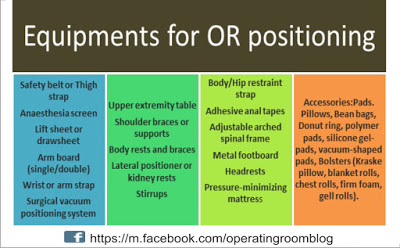The equipment used for positioning in the operating room are designed to stabilize the patient in the desired position and thus permit optimal exposure of the surgical site.
What safety precautions should be observed while transferring, moving, and positioning of patients in the OR?
1. Proper identification of patient before being transferred to the OR bed, and confirmation of the surgical site according to facility policy.
2. Assess the patient’s mobility status.
3. Ensure that the OR bed and transport vehicle are securely locked in position. …
4. Two people should assist an awake patient with the transfer by positioning themselves on each side of the patient’s transfer path.
5. Ensure adequate assistance in lifting unconscious, anaesthetized, obese, or weak patients is necessary to prevent injury. A minimum of four people is recommended, and transfer devices and lifters may be used.
6. The anaesthetist guards the head of the anesthetized patient during movement.
7. The surgeon assumes responsibility for protecting an un-splinted fracture during movement.
8. The anaesthetist’s permission must be sought before moving the anaesthetized patient.
9. The anesthetized patient is moved slowly and gently to allow the circulatory system to adjust and to control the body during movement.
10. No body part should extend beyond the edges of the OR bed or contact metal parts or unpadded surfaces.
11. Body exposure should be minimal to prevent hypothermia and preserve dignity.
12. Movement and positioning should not obstruct or dislodge catheters, intravenous (IV) infusion tubing, oxygen cannulas, and monitors.
13. During articulation of the OR bed, the patient is protected from crush injury at the flex points of the OR bed.
14. When the OR bed is elevated, the patient’s feet and protuberant parts are protected from compression by overbed tables, Mayo stands, and retractor frames.
15. Surfaces should not create pressure on any body part.References
– Akhavan, A, and Gainsburg, D. M., Stock JA: Complications associated with patient positioning in urologic surgery. Urology 76(6): 1309–1316, 2010.
– Phillips, N. (2013). Berry & Kohn’s operating room technique. Missouri: Elsevier Mosby.
– Rozet I, Vavilala MS: Risks and benefits of patient positioning during neurosurgical care. Anesthesiol Clin 25(3):631–653, 2007.

